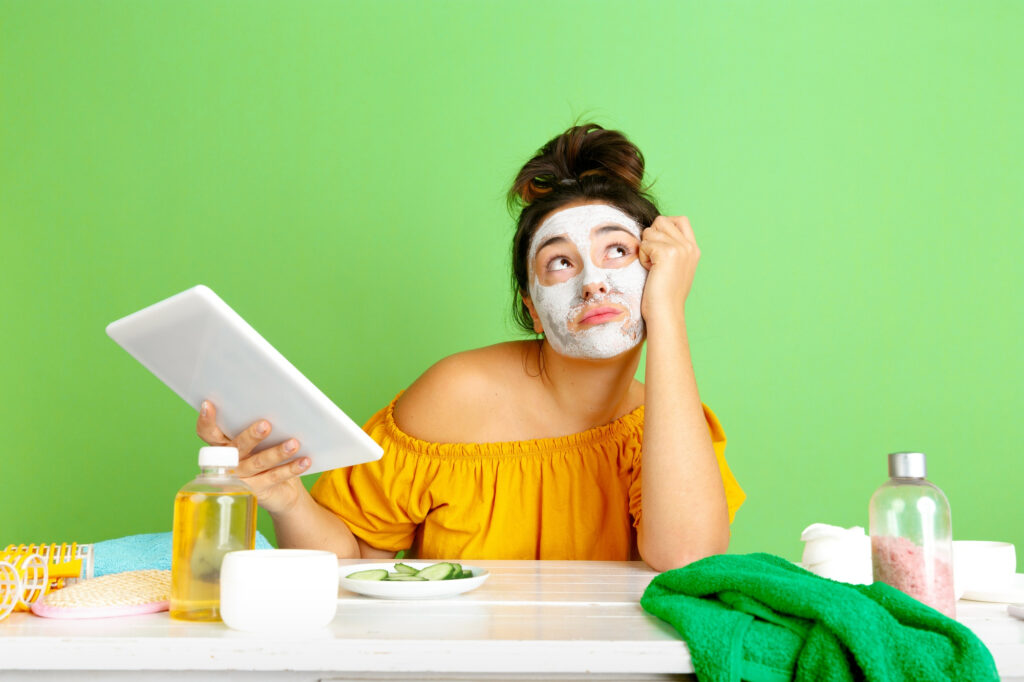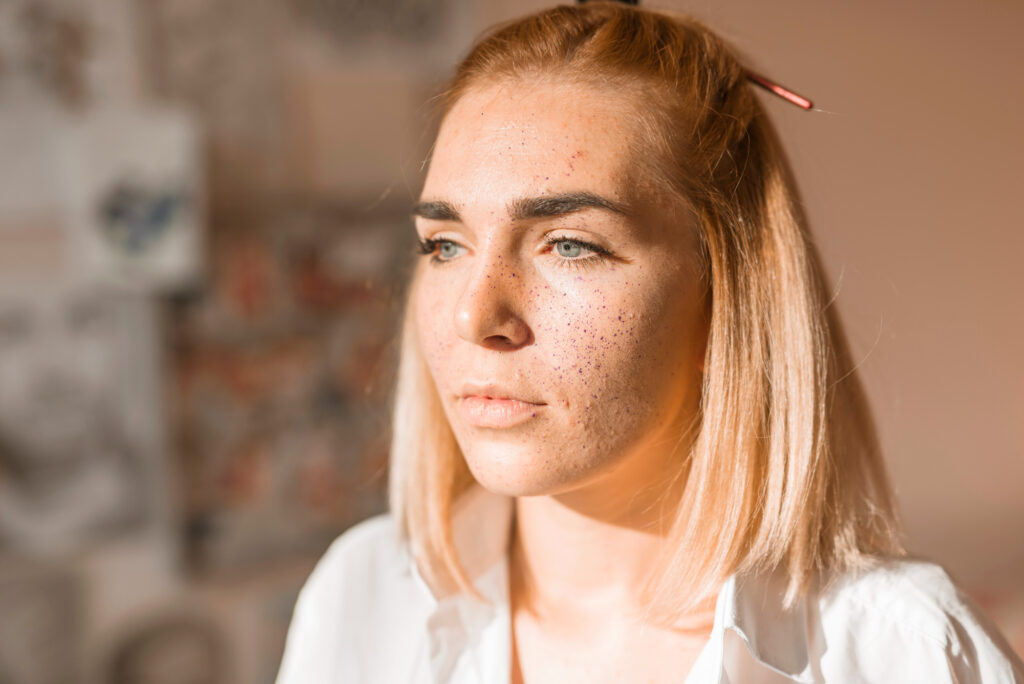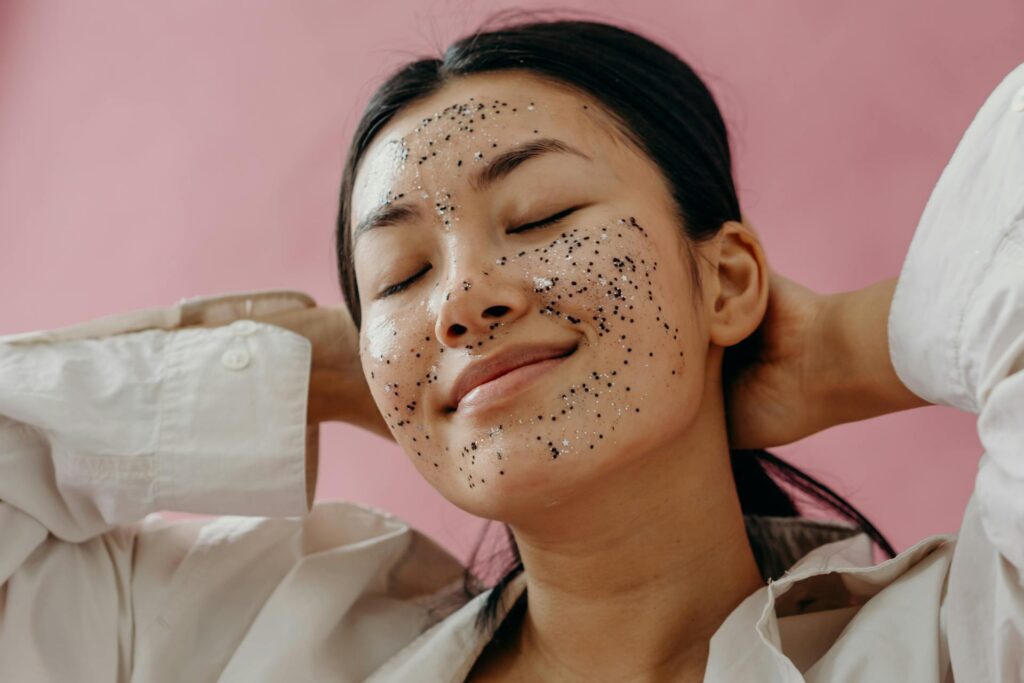
Having smooth, glowing skin is something we all desire, but dead skin cells can sometimes make our faces look dull, dry, and uneven. The good news is that there are many simple and effective ways to get rid of dead skin on your face, leaving your skin looking fresh and radiant. This article will guide you through the top methods to remove dead skin using easy-to-understand language. Whether you’re new to skincare or a seasoned pro, you’ll find these tips helpful.
Understanding Dead Skin: What Is It and Why Does It Build Up?
Our skin is constantly renewing itself. The outer layer of your skin, called the epidermis, sheds old, dead skin cells and replaces them with new ones. This process is called cell turnover, and it helps keep your skin looking fresh and healthy.
However, sometimes dead skin cells don’t shed as quickly as they should. When this happens, they can accumulate on the surface of your skin, leading to a dull, flaky, or rough texture. There are several reasons why dead skin might build up:
- Aging: As we get older, the process of cell turnover slows down, which can cause dead skin cells to stick around longer.
- Dry Skin: When your skin is dry, it doesn’t shed dead skin cells as efficiently, leading to flakiness and rough patches.
- Sun Damage: UV rays can damage your skin, slowing down the cell turnover process.
- Lack of Exfoliation: If you don’t exfoliate regularly, dead skin cells can pile up on your skin’s surface.

8 Best Ways to Get Rid of Dead Skin From Your Face
Now that we know why dead skin builds up, let’s look at the best ways to remove it.
-
Exfoliation: The Most Effective Way to Remove Dead Skin
Exfoliation is the process of removing dead skin cells from the surface of your skin. There are two main types of exfoliation: physical and chemical. Both methods are effective, but they work in different ways.
Physical Exfoliation
Physical exfoliation involves using a tool or scrub to physically remove dead skin cells. Here are some popular methods:
- Facial Scrubs: These are products that contain tiny, gritty particles that help scrub away dead skin. Look for gentle scrubs with natural ingredients like sugar, oatmeal, or ground nuts. Be careful not to scrub too hard, as this can irritate your skin.
- Exfoliating Brushes: These are soft brushes that you use in circular motions on your face to buff away dead skin. Electric facial brushes are also available and can make the process easier.
- Microdermabrasion: This is a more intense form of physical exfoliation that you can get at a spa or dermatologist’s office. It uses a special machine to remove the top layer of dead skin, revealing smoother skin underneath.
|
Pros |
Cons |
| Immediate results | Can be too harsh if done too often |
| Smoother skin texture | Especially for sensitive skin |
Chemical Exfoliation
Chemical exfoliation uses acids or enzymes to dissolve the bonds between dead skin cells, allowing them to shed more easily. Here are some common chemical exfoliants:

- Alpha Hydroxy Acids (AHAs): AHAs like glycolic acid and lactic acid are great for removing dead skin cells and improving skin texture. They are especially good for dry or sun-damaged skin.
- Beta Hydroxy Acids (BHAs): Salicylic acid is a well-known BHA that is oil-soluble, making it perfect for oily and acne-prone skin. It penetrates the pores to remove dead skin and excess oil.
- Enzyme Exfoliants: These use natural enzymes from fruits like papaya or pineapple to gently break down dead skin cells. They are usually milder and suitable for sensitive skin.
|
Pros |
Cons |
| Effective and gentle | Can cause irritation if overused |
| Suitable for various skin types | Requires careful selection based on skin type |
For more information on choosing the right exfoliant for your skin, check out this helpful guide from Healthline.
-
Moisturizing: Keeping Your Skin Hydrated
Moisturizing is essential for maintaining healthy skin and preventing dead skin buildup. When your skin is properly hydrated, it’s less likely to become dry and flaky.
- Choose the Right Moisturizer: Pick a moisturizer that suits your skin type. If you have dry skin, look for a rich cream or ointment that contains hydrating ingredients like hyaluronic acid or glycerin. If you have oily or combination skin, choose a lightweight, oil-free moisturizer.
- Apply Moisturizer to Damp Skin: After cleansing or exfoliating, apply your moisturizer while your skin is still slightly damp. This helps lock in moisture.
- Use Humectants: Humectants like hyaluronic acid attract moisture to your skin, keeping it hydrated and plump. This can help prevent the buildup of dead skin cells.
|
Pros |
Cons |
|
Keeps skin hydrated,. |
Using the wrong product can lead to breakouts for some people |
|
Helps prevent flakiness |
For tips on finding the best moisturizer for your skin type, visit the American Academy of Dermatology’s moisturizer guide.
3. Cleansing: The Foundation of a Good Skincare Routine
Regular cleansing is crucial for removing dirt, oil, and dead skin cells from your face. Here’s how to make sure you’re doing it right:
- Double Cleansing: This method involves using an oil-based cleanser to remove makeup and sunscreen, followed by a water-based cleanser to wash away dirt and impurities. This ensures that your skin is thoroughly clean.
- Use a Gentle Cleanser: Choose a cleanser that’s gentle on your skin. Avoid harsh soaps or cleansers with strong fragrances, as they can strip your skin of its natural oils, leading to dryness.
- Cleanse Twice a Day: Cleanse your face in the morning and at night to keep your skin free from dirt, oil, and dead skin cells.
|
Pros |
Cons |
|
Essential for healthy skin |
Over-cleansing can lead to dryness and irritation |
|
Helps prevent clogged pores. |
For more advice on choosing the right cleanser for your skin type, take a look at this article from The Derm Review.
4. Facial Masks: Give Your Skin a Boost
Facial masks can be a great addition to your skincare routine, helping to remove dead skin cells and rejuvenate your complexion. Here are some types of masks that can help:

- Clay Masks: These masks are excellent for absorbing excess oil and drawing out impurities from your pores. They can also help prevent dead skin buildup, making them a good choice for oily or acne-prone skin.
Also Read: Are Clay Masks Good for Dry Skin? The Ultimate Guide
- Peel-Off Masks: Peel-off masks adhere to the surface of your skin, and when you peel them away, they remove dead skin cells and impurities. However, they can be harsh, so use them sparingly.
- Hydrating Masks: Hydrating masks contain ingredients like hyaluronic acid or aloe vera that provide moisture while helping to soften and lift dead skin cells.
|
Pros |
Cons |
| Provides deep cleansing | Some masks can be too harsh for sensitive skin |
| Can target specific skin concerns | Have to use them sparingly |
For more information on choosing the right facial mask, visit Allure’s guide on facial masks.
5. Professional Treatments: When to See a Dermatologist
If you’re struggling with dead skin buildup and at-home methods aren’t giving you the results you want, it might be time to see a dermatologist for professional treatments. Here are some options:

- Chemical Peels: Chemical peels use stronger acids to exfoliate the skin deeply. They remove multiple layers of dead skin, revealing fresh, new skin underneath. Chemical peels come in different strengths, from mild to deep, depending on your needs.
- Laser Treatments: Laser treatments can effectively remove dead skin and stimulate the production of new skin cells. This method is particularly effective for addressing more severe skin concerns, such as deep wrinkles or acne scars.
- Dermaplaning: Dermaplaning is a procedure that involves using a special tool to gently scrape off dead skin cells and fine facial hair. It’s painless and leaves the skin incredibly smooth and soft.
|
Pros |
Cons |
| Provides professional results | Can be costly |
| Can address more severe issues | Some treatments require downtime |
For more information on professional skin treatments, explore WebMD’s guide to cosmetic dermatology.
6. Lifestyle Changes: Support Your Skin from the Inside Out
Your lifestyle plays a significant role in the health of your skin. Here are some tips to help prevent dead skin buildup from the inside out:
- Stay Hydrated: Drinking plenty of water is essential for keeping your skin hydrated and healthy. When your skin is well-hydrated, it’s less likely to become dry and flaky.
- Eat a Balanced Diet: A diet rich in fruits, vegetables, and healthy fats provides the nutrients your skin needs to function properly. Omega-3 fatty acids, in particular, can help keep your skin moisturized and supple.
- Get Enough Sleep: Sleep is when your body repairs and regenerates cells, including your skin cells. Aim for 7-9 hours of quality sleep each night to support healthy skin.
Also Read: What is Skin Fasting and How Does It Work? | Transform Your Skincare Routine!
|
Pros |
Cons |
| Promotes overall skin health | Requires consistency |
| Helps prevent skin issues | Long-term commitment |
For more tips on how to support healthy skin through diet and lifestyle, check out this article from Harvard Health.
7. Using Natural Remedies: Gentle and Effective
Natural remedies can be a gentle and effective way to remove dead skin cells. Here are some popular natural exfoliants:
- Honey: Honey is a natural humectant, meaning it helps retain moisture in your skin. It also has mild exfoliating properties, making it great for dry or sensitive skin.
- Oatmeal: Oatmeal is a gentle exfoliant that can help remove dead skin without irritating. Mix it with water or yogurt to create a soothing face mask.
- Sugar Scrubs: Sugar is a natural exfoliant that can help slough off dead skin. Mix it with a little olive oil or honey for a moisturizing scrub.
|
Pros |
Cons |
| Gentle on the skin |
May not be as effective as chemical exfoliants for more severe dead skin buildup |
|
Easy to find ingredients |
For more information on natural remedies for skin care, visit this guide from Medical News Today.
8. Avoiding Common Mistakes: Protect Your Skin
When trying to remove dead skin, it’s easy to make mistakes that can actually harm your skin. Here’s what to avoid:
- Over-Exfoliating: It’s important not to exfoliate too often. Over-exfoliating can strip your skin of its natural oils, leading to dryness and irritation. Aim to exfoliate 1-3 times a week, depending on your skin type.
- Using Harsh Products: Avoid using products with strong fragrances, alcohol, or harsh chemicals, as they can irritate your skin and make dead skin buildup worse.
- Skipping Sunscreen: After exfoliating, your skin is more sensitive to the sun. Always apply sunscreen during the day to protect your skin from UV damage.
|
Pros |
Cons |
| Protects your skin from damage |
Requires awareness and careful product selection |
|
Helps maintain healthy skin |
For more information on avoiding common skincare mistakes, check out this article from the American Academy of Dermatology.
Final Thoughts
Dead skin buildup is a common issue, but with the right techniques and products, you can easily remove it and keep your skin looking smooth and radiant. From exfoliation and moisturizing to professional treatments and lifestyle changes, there are many ways to get rid of dead skin on your face. Remember to choose the methods that work best for your skin type and be consistent with your skincare routine.
For more skincare tips and advice, you can visit Dermstore’s skincare blog for a wealth of information on how to care for your skin.
By following these tips, you’ll be well on your way to achieving a healthy, glowing complexion that you can feel confident about every day.
FAQ: Top Ways to Get Rid of Dead Skin on the Face
- What are the best methods for exfoliating dead skin on the face?
Exfoliation is the most effective way to remove dead skin cells from the face. The two primary methods are physical exfoliation, which involves using scrubs or brushes to manually remove dead skin, and chemical exfoliation, which uses acids like AHAs (alpha hydroxy acids) and BHAs (beta hydroxy acids) to dissolve the bonds between dead skin cells. Both methods are effective, but they work differently and should be chosen based on your skin type and sensitivity. Physical exfoliation provides immediate results but can be abrasive if overdone, while chemical exfoliation is gentler and works over time to reveal smoother skin.
- How often should I exfoliate my face to remove dead skin?
The frequency of exfoliation depends on your skin type and the method you use. For most people, exfoliating 1-3 times a week is sufficient. If you have sensitive skin, you may want to stick to once a week to avoid irritation. Those with oily or acne-prone skin might benefit from more frequent exfoliation, especially with chemical exfoliants like salicylic acid, which can help keep pores clear. It’s important not to over-exfoliate, as this can damage your skin’s protective barrier, leading to redness, irritation, and increased sensitivity.
- Can I use both physical and chemical exfoliation together?
Yes, you can use both physical and chemical exfoliation, but it’s important to do so carefully to avoid over-exfoliating your skin. Many people find it beneficial to alternate between the two methods. For example, you might use a gentle physical scrub once a week and a chemical exfoliant like glycolic acid on another day. This approach allows you to enjoy the benefits of both methods without overloading your skin. However, if you notice any signs of irritation, such as redness or sensitivity, reduce the frequency or intensity of your exfoliation routine.
- What ingredients should I look for in a chemical exfoliant?
When choosing a chemical exfoliant, it’s essential to select one that suits your skin type and concerns. For dry or mature skin, AHAs like glycolic acid or lactic acid are ideal because they not only exfoliate but also hydrate the skin. BHAs like salicylic acid are better suited for oily and acne-prone skin because they are oil-soluble and can penetrate deeper into the pores to clear out excess oil and dead skin. Enzyme exfoliants, which use natural enzymes from fruits like papaya or pineapple, are a gentler option and are suitable for sensitive skin.
- Are there any risks associated with exfoliating the face?
While exfoliation is beneficial for removing dead skin and improving your complexion, there are some risks if it’s not done correctly. Over-exfoliation can lead to irritation, redness, and even breakouts. It can also strip the skin of its natural oils, leading to dryness and sensitivity. To minimize these risks, choose an exfoliant that matches your skin type, follow the recommended usage frequency, and always moisturize your skin afterward. If you’re new to exfoliation or have sensitive skin, start with a milder product and gradually increase usage as your skin adjusts.
- What is the role of moisturizers in preventing dead skin buildup?
Moisturizers play a crucial role in preventing dead skin buildup by keeping your skin hydrated and supple. When your skin is well-moisturized, it’s less likely to become dry and flaky, which helps prevent dead skin cells from accumulating on the surface. Moisturizers with ingredients like hyaluronic acid, glycerin, and ceramides help lock in moisture and strengthen the skin’s barrier, making it more resilient to environmental factors that can lead to dryness and dead skin buildup. Applying moisturizer right after exfoliating is particularly effective, as it helps soothe the skin and replenish lost moisture.
- How can I tell if my skin is over-exfoliated?
Over-exfoliation can happen when you exfoliate too frequently or use products that are too harsh for your skin. Signs of over-exfoliation include redness, irritation, increased sensitivity, dryness, and sometimes even breakouts. Your skin might also feel tight or uncomfortable, and you may notice an uneven texture. If you suspect you’ve over-exfoliated, stop exfoliating immediately and focus on soothing and hydrating your skin with gentle, moisturizing products. Give your skin time to recover before resuming any exfoliation, and when you do, start with a milder product and use it less frequently.
- Are there natural remedies for exfoliating dead skin on the face?
Yes, there are several natural remedies you can use to exfoliate dead skin on the face. Some popular options include:
- Honey: Honey is a natural humectant with mild exfoliating properties. It helps retain moisture in the skin while gently removing dead skin cells.
- Oatmeal: Ground oatmeal can be used as a gentle scrub to exfoliate the skin. It’s particularly good for sensitive skin because it soothes irritation while exfoliating.
- Sugar Scrubs: Sugar is a natural exfoliant that can help slough off dead skin. Mixing sugar with honey or olive oil creates a simple and effective exfoliating scrub.
While natural remedies can be effective, it’s important to be gentle and test any new ingredient on a small area of skin first to ensure you don’t have an allergic reaction.
- How can lifestyle choices impact dead skin buildup on the face?
Your lifestyle choices have a significant impact on your skin’s health and can contribute to dead skin buildup. For example, staying hydrated by drinking plenty of water helps keep your skin moisturized from the inside out, reducing the likelihood of dryness and dead skin buildup. Eating a balanced diet rich in fruits, vegetables, and healthy fats provides your skin with the nutrients it needs to function properly. Getting enough sleep is also crucial, as your skin repairs and regenerates itself during rest. Finally, protecting your skin from sun damage by using sunscreen can prevent the slowing of the cell turnover process, which can lead to dead skin accumulation.
- When should I consider seeing a dermatologist for dead skin issues?
If you’ve tried at-home methods for removing dead skin and haven’t seen the results you want, or if you’re experiencing persistent issues like severe dryness, flakiness, or irritation, it might be time to see a dermatologist. A dermatologist can evaluate your skin and recommend professional treatments, such as chemical peels, microdermabrasion, or laser therapy, which can be more effective for stubborn dead skin buildup. They can also provide personalized advice on how to care for your skin and recommend products that are best suited to your specific needs.

